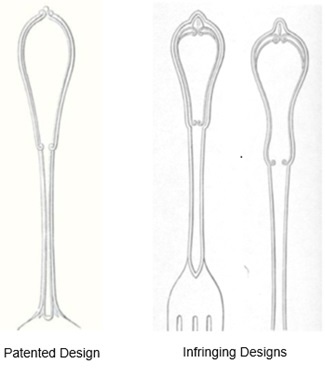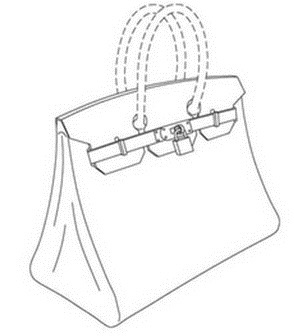By Michael K. Friedland
There is nothing more satisfying than developing a breakthrough, viral new product in the world of fashion. And nothing more frustrating than seeing it copied.
The exclusive, hard-to-get, must-have look becomes commonplace and mundane. Sales and profits evaporate, and even the original, genuine articles end up remaindered.
But it does not have to be that way.
Fashion can be protected with the right IP, through a combination of design patents, trade dress, trademarks and copyrights.
For fashion goods, IP is not one-size-fits-all. Different types of products need different types of IP protection.
In this article, I will discuss the right IP for fashion different types of fashion goods.
Let us say that you have just designed a product that has a new look, and you are pretty confident that the design could become a staple—or will, at least, be around for more than a few seasons. A design patent may be the perfect way to protect it.
Federal patent law allows a designer to obtain a design patent for products featuring new and original ornamental designs.
The designer, though, must act quickly. He or she must file the application no later than one year after the designer, (1) disclosed the design in print, including on the Internet, (2) publicly used or placed the design on sale, or (3) otherwise made the design available to the public.
The design patent application itself is relatively straightforward. It requires little more than drawings, renderings, or black-and-white photographs.
Once obtained, design patents are well-suited to the protection of fashion items. Examples of issued design patents for fashion include, a Lululemon swimsuit, a Rolex watch face and a Chanel handbag.
 Lululemon swimsuit
Lululemon swimsuit
 Rolex watch face
Rolex watch face
 Chanel handbag
Chanel handbag
A design patent can cover an entire product or a component of a product, as shown in the design patent above for a watch face alone.
The decision of whether to patent the entire product or components often depends on whether a company is concerned that an infringer might just copy parts of the design.
A company might decide to obtain design patents on an entire eyeglass frame and, in addition, separate design patents for the eyeglass face and the ear stems.
The Patent Office typically issues design patents within nine to 12 months of filing. And they are long lasting. A design patent remains in force for 15 years after issuance.
Enforcement of a design patent is also straightforward.
To prove infringement, a designer need only show that “an ordinary observer,” would be deceived into believing the knockoff is the same as the patented design.
This means that the designs do not need to be identical.
In a recent case involving footwear-maker Crocs, a court of appeal emphasized that minor differences between a patented design and an accused article’s design did not prevent a finding of infringement.
In a 19th century case involving silverware maker Gorham, the Supreme Court upheld a finding of infringement, even where differences between the designs were all that subtle.
The Supreme Court found that the two pieces of silverware on the right infringed the design on the left, despite observable differences.
 Gorham silverware
Gorham silverware
When a designer can prove infringement, the designer can obtain an injunction, disgorgement of all of the infringer’s profits, the designer’s lost profits or a reasonable royalty.
In some cases, the designer can also obtain treble damages and an award of attorneys’ fees.
Established product with a distinctive design
Now let us consider a product that is already a success. It has been on the market for at least a few years, sales are solid, the marketing budget is substantial, and customers already associate the design with your company.
Although it is too late to file a new design patent – the product has been on the market for more than one year – trade dress might be perfect.
Trade dress protects the “total image and overall appearance” of a product.
Trade dress generally can cover product configurations, product designs and product packaging.
Features such as the size, shape, color or color combinations, texture and graphics can all qualify for trade dress protection.
Trade dress does not need to be registered with the Trademark Office to be enforceable, but there are presumptions and additional remedies that make registration preferable.
A product’s trade dress may be a collection of elements that are not separately protectable as trademarks, but which together, can identify the source of a product or service.
The features must also be “nonfunctional” – not essential to the use or purpose of the product or providing a competitive advantage to the product.
Unlike design patents, which only last 15 years, trade dress can last indefinitely, so long as the owner continues to use it and enforces it against infringers.
Examples of issued trade dress registrations include Christian Louboutin’s famed red lacquered sole, Adidas’ three stripe design and Hermès’ Birkin handbag design.
 Christian Louboutin’s famed red lacquered sole
Christian Louboutin’s famed red lacquered sole
 Adidas’ three stripe design jacket
Adidas’ three stripe design jacket
 Hermès’ Birkin handbag design
Hermès’ Birkin handbag design
The fact that a company already has a design patent on the design does not preclude the company from relying on trade dress.
A company can initially protect a design with a design patent – which lasts only 15 years – and later seek trade dress protection, which can last indefinitely.
To win a trade dress infringement action, a brand must show: (1) distinctiveness, (2) non-functionality, and (3) a likelihood that relevant consumers will be confused.
To show distinctiveness, the brand owner needs to prove that the design has acquired “secondary meaning” – that the product’s design is associated with a particular source.
This can be shown through the length of time the maker has sold products with the design, the volume of sales, the amount of advertising, consumer surveys, consumer testimony, and the defendant’s intent in copying the trade dress.
The remedies for trade dress infringement are the same as those for trademark infringement: injunctions, disgorgement of the infringer’s profits, lost profits, a reasonable royalty, and/or attorney’s fees in “exceptional” cases.
Product featuring an image or three-dimensional ornamentation
Let us say that the product incorporates an original image or sculpture that could exist separately from the product itself.
Copyright can protect the artwork or image printed on a T-shirt or any other article of clothing.
Similarly, the design of a pattern on fabric, such as an original floral, paisley or geometric design, the design of an embroidery pattern, or the design of a piece of jewelry or an engraved design on the back of a watch may be protected.
Note that copyright will not protect the product itself – just the image or sculpture.
Even simple geometric designs on clothing can be protected by copyright.
In 2017, the U.S. Supreme Court ruled that the designs on a cheerleading uniform were copyrightable, even though they consisted of little more than geometric blocks of colors and stripes.
 Cheerleading uniform designs
Cheerleading uniform designs
Courts have similarly found that copyrights could protect simple jewelry designs.
 Necklace design
Necklace design
To prove infringement, a plaintiff must show that the defendant copied the plaintiff’s copyrighted work. Because direct evidence of copying is frequently difficult to obtain, a plaintiff can meet that burden by providing evidence showing that the defendant had access to the plaintiff’s work and that the two works are substantially similar.
Two general forms of damages are available for copyright infringement.
First, the copyright owner can obtain its actual damages, such as lost profits, and any additional profits made by the infringer.
Second, in the alternative, the copyright owner may obtain statutory damages. Statutory damages can be as low as $200 and as high as $150,000 for each copyright infringed.
Product with a great brand name, product name, logo, color or pattern
Let us say the product has a great name or logo. For that product, you will want to look to trademarks.
Trademark can protect, among other things, company names (ROLEX), product names (BIRKIN), slogans (JUST DO IT), logos (Gucci G’s), colors (Tiffany blue) and fabric patterns (Burberry check pattern).
Trademarks allow owners to prevent others from using the same or similar trademarks on the same or similar products where the use is likely to cause confusion.
Unlike patents and copyrights, trademarks do not expire after a set term.
Instead, trademark rights originate from, and are perpetuated by, actual “use.” Therefore, in theory, trademark protection can last forever, so long as the owner uses the mark and enforces it against infringers.
The stronger a trademark is, the easier it is to enforce. Thus, where possible, a company should pick strong trademarks.
Courts generally view trademarks as ranging from generic on the weakest end of the spectrum (no protection) to fanciful on the strongest end (greatest protection). To illustrate, consider several product names for watches, listed from weakest to strongest.
| Category | Example | Comment |
| Generic | WATCH | A generic term is merely the name for the product. It receives no trademark protection. |
| Descriptive | DAY-DATE | A descriptive trademark clearly describes a feature or characteristic of the product (the watch tells the day and the date). It is only protectable if the company can show the consuming public associates the trademark with the company. This can be shown with long use, substantial sales, significant marketing, or other evidence of consumer recognition, such as surveys. |
| Suggestive | TIMEX | A suggestive trademark hints at or suggests the nature of the product or service without actually describing the product. |
| Arbitrary | CITIZEN | An arbitrary trademark is a word that can be found in the dictionary but has no meaning that relates to the product. |
| Fanciful | ROLEX | A fanciful trademark is a word that is invented for the sole purpose of serving as a trademark and does not hint at or suggest the nature of the product. |
Federal registration is not required to have trademark protection, but it is valuable because it creates certain presumptions and gives additional remedies to a trademark owner.
To successfully enforce a trademark, an owner must show that there is likelihood of confusion between the owner’s trademark and the competitor’s trademark among members of the relevant consumer population.
This is shown by considering a number of factors, such as the strength of the trademark (as described in the table above), the similarity of the trademarks, the similarity of the products, the similarity of the marketing channels, the degree of care exercised by their consumers, and whether there have been actual instances of confusion, which can be shown by surveys.
If the trademark owner can prove infringement, the owner may obtain an injunction, disgorgement of the infringer’s profits, lost profits, or a reasonable royalty. A court may also award attorneys’ fees in some cases.
DEVELOPING THE RIGHT IP strategy for each product requires careful consideration of the product’s lifecycle, the nature of the product, and the product’s place in the market.
For some products, design patents should be obtained both for the overall product and individual components.
Many products will benefit from multiple overlapping forms of IP protection. It is common for products to first be protected by as design patents, then trade dress.
Fabric patterns and logos can often be protected by both copyright and trademark.
For valuable fashion products, IP strategies should be bespoke, not ready-to-wear.
Michael K. Friedland is a partner of Friedland Cianfrani LLP in Irvine, California. Reach him at mfriedland@fciplaw.com.
{"ct":"adDeoKZmtBewITu3Sc50bXhnZAQZ1XrM\/9di8DmyMP4cicRxVUU\/JrD+YdALvNfdsDtMdMmQflT\/hNPawLCCcuK16HI8IT6ET+ybumtm6Vp8YjnMfwsl0pJe7fNRKV51KEFBzICYPx0Vk0uy2srVPhRp3Inw80r5Ue5YsrEZbLbOMYTd2o8qpWHWPDbwPVFSymr6n1Ji6aOddJ1N+WGzeFeI9cRz3y69VcS8N+ckmevr1AC\/Yu04oW4PjeNSk4uRBbDjtxibWg7x5hY+88mdI+iXj6iEYQDCElXR9tNFwawjjLLti19+LgS8ddLvaM9OuNDgEOK2bVsT\/zEox8XxQme2AmpJhg\/1JdBcr4+uFlg73yE737WlQWVEMyJYf7HcfEO2NhfK3y7BMfNlxv\/tdpciCpqbT5KRzv7aePNmSn1e9V2N7FKbYMne8hJcRt\/L+kFGMvj6A6b\/Y5GwdRLsWd4i0Mn2KekheLi2O73wNBqrustq4WN6CvyUHuEVxhJhmmRi3yWFhMpBXtouQkhZhzLTUncSwLrmwKp2G+m\/tUX7SgizQX6q6diZ\/tPdj7r4Fgqx2JRXK8PZG0GMM98Ci2NuHz+HR0rlCRwJnUk4bhLjB7MYl5OxD\/5op4NuctjCpcknessvILMfNWkiQE\/rs9\/i4m1FWzIC6J4XrstJ6Mkld\/m8ZGH1RGr+KIj3o30xR44OxDPOMbx0TBdN\/LreZpora676epzuUtGWb3nYosT\/9yMOQ0fc6gi7BE4lRccF4MrQ7nigQEUr1AIAiNGHPmgOjN6cMnEtezKNQI8jYPnXLqsdY1rKuze4JzfU3gcMmC08JAxWiz01CJnihw71jjHW\/CcVAQs4nAJ41gveuqWVTUbvbSYKSDdOVbEZVVbARRtIsN03el6eFQLoTovAJ6XGV8CKAuXPc5s0\/w9Ngar\/\/lvu6d3WTgEV57huJKqn0pU13K4O862ydtjOaekZjAT7nPJK7I55C8HHjPG9BZoI5wrXBZiC1+qjoQz02ijyODQ2wwW70qwfPoXUs8o1cSP9M0T4q1+FBrhcxgVlYg0odC9WC3octEtrsYRyk9pdrdKNvGq9cWL4LJf5dl5b1RknrAPvCfFR0\/jn+nox3xFU3MUJlwaSExcNxllvVcqOfFiQnySdaE3Tj+zNUobDPO9oufoJLzGROe7eOoon8+5r8gx6OBqCysklCDNUrc6r4U0h4SKG7ytlPBP2KGj2TiX3vs6rCEQ3y4hgPvCf4nS6qtW1niC6eCIjhICK9xPTTVDU8UHhr5LkDuUWPskoImUOuM3MFsxbis9DYu7B1towY3BGgcEkyFh7gRgoaBsWFC3x4GkG\/EQgercNvPIm\/zVuwF7COMKzHuZ4bz922E+ZfyWYTBdEYZHhDSJFFTiQLDF+8Sg3brP8B++fBMTGhbzvK\/+Rbe9EQa91OB0FO\/BxThA48LbICBfZh+EVMJqLIjjdWBzeBJzt4QSe\/Gh53X90tr\/iQzx55iRNpjhJw+G18bLZiCNXyspARmoxkWQ+KY6GnF4CrOy9vNdREy3iDoqr52l3qDTpJVMNFELTsDQ381VHlfAzQmQsSfjoAtK4Pq0IBgCPjgZ9MksQZsL\/mNpCFo9zjg6oQ1gVGmZtIE14898vuIIK9nL3Vpg9OV3ZaymPNOSeV44WY96RgB7eTPm32JCzzmuEbcF7bmY2L9+Lz8uVnDup39WtuE8sAtHIfb88q1kit86urVBS5jYR\/\/dHY1JsmVwrJFaiAxXN7QWSvS61vFQJviNJg1NwNgwxUv3URoTpBWebo3Ig7Uab481VTGtwlpYWUMDhUE3TM23MQFNurm3dT+txEIum+t2vDjgD21QqwoMX8g1tJYbE65TxaC\/jkQmM301d\/eaXYOCsuPbK7PzBkFiZS8V4co0JuVcJXSqMnmXgVtRtL0zKSViCgnBsAPO81Pe9gBEGsStv48XMT0mRhFr3mVh3rs15xCAd6ioIcqjEOQ571z9r+ds6dvvInrpBoH\/3uJ3CxYKi0IylzZO8\/CtU2y4kO64rHR8Q56502VRQR0Qh13iwYuHxXM+2yHhSdqgNB29rw4zxv1eDziV6MJAJzgj7+MJX9zBQLX3M7vSFRnL6DXR14u7UxvPFscKyal3KXWPE6QQB7oHUCFum6jy4d3rm07mrt8g9pzHnLATvLi9Dx75KcGDCVlmZxHbdP3oGW\/BBcOEiJ9VxLsL2MtK\/NevbOJOT28xsZkAlnQqCt4GWi\/73yfk+igAJm9IpdEIqG3aAsYWeCUvEJFKWspCgTc3DwsqNUhWNcencqLSlucuzm1DCrl0Yt9Mkp8qMBJhqnJW9f97dMR6NXeUeKZqhjYlDuSGSIWlm7zux+l2+h8xuwRe\/zch64lvFcKt8loSc1losHqyqiZO5zEwdaO6MrVlJJtzcLJlZc5iLdq3RlOsPYVdi5evhBSs0ZeQA\/DGqzkHRR0PsGIWb5jiNEz1uXTxpa2FBI7kQe6og5s7zTzcA1TTAjmXaUQoF3XCmIBYPN\/B0MVNyN3xALp59ymOvXbBGT27Ihem2jhMqPJ7AIzISl0KW7SqTmConJjvjuxivSoVM\/R+cXLaZw4v+T2e8jDzDgrbLEChvlOoxNx6fyy+eYG7CZsRyjJhRN+hxskRmC1oQbnvVkoq5V2HEO7M6G80OqmyfwOO5T0FUYFUS9HqZxFauqSfUG5xcrfYuOnYXFzf3XU4tNWbFqgnU2N1jK4Pd1oDI0piGBsHn\/07A5IkmVCtoUWANtDB1RBqYKJjjq8PQVewY7ho41cv03mDCkai5vr9bWry4XEmMXRPP8zXfR8n2VmP\/YzjvF4QPC5WI7lSvNeQUamdEv3HMylaqNhdxSqjQ2BlTudgtQvhbwcbglNnP0cE1U9wxrufqYgT4xuQ5wSeQ933xs6rgBLfghA03sSnkzBpOn5RGLKOrQe0Si77iTPvty2bBMbRWDPjxMOTP9a1LJAZ5COJSGQPVPkbK73BittH7TuQWGV+ffI\/Fa5jh5btqI7hDzGPwdzREaavnwMrb1Wci9QiV+hVn\/cD5jzwhidFNxrtuammQCcDnCKx2FqZfb2S8s8lGo0xEMO1mY0Hp40MD2CUvKQfKdrYq\/e02vk5o4uvTdKQJgNMnEj8qYPa1vBOKddaWCgdakujOVELCSlgPEG3wOiw8P6YyTmPJJvEozlqLCBEos4+1lP8ryq\/yXLZNhnr5yHCG+\/CPSU7gk3pkB6jxyUJjtKVDaVObo66056l5VT7T\/etCY0fziVq9SwqppxzdwavA5NhmoS4N4Gmct\/Lb\/5vwkWTfsYjQYDcs\/5wrW+CPEcW5qgERuXR01aoexvixrHjnqxksPUiY2IU\/iwsDVt0ZPSjeOPJA5upjAB\/dEqnWsW5wzjm1KdXL4hCBcc3Nw\/ncgH0Jw6dSLoxip5tOcMpdS4QW6OYWJiJXlkeAMpbIccwu7nmo0B1z2DCgsYe\/afo+y3y6c\/UjoiJQWQal\/wt1r5WdqwlUdHhVzZHj+FCRqqtsUEzBKtBmzhWXOh4tpKjQjsQhAXL0ykXKxy6X0o4Te8yay2SvXjpkLT7o6C1ZPebkIZ1EdKpB\/kXuD4T1\/OVzrl3PdOkpgHOSNTVMpq7JcOnBPMDvfBwAvJeBHYt\/ebH0LaYfatIKA5i5fedyUmA+cxl\/FX\/8\/CI\/Ke433bkGE4MWPH\/kEHX9UMe0a0gXJCqIP3XlLtxbTqCmT4iufRhqkYC7JiWLU1okuFt3d4Ax9VhDZedEBbi\/+HYZ3AIrrf9mCtulIKdxLhZU0FSqKCirfXJ+rYCiOhQYd6QnsyOmwQwgnZlyqMktG0+aon0EhxVyJglgO+2l5XbF5FQEiA\/NL80hGLWwha9v+yGGlzQbMiCtCU1+osovjiwwSBW+CyNDpDSXIpc1ye3f5g0779jUWZ3TvAggjZq\/lmuye0HfCrj0yL+TtzyIeir0G5CJ5Xi4u4iuIeEEB\/7WTxS76jcDSlltSjatU2dixVMKSJ4YAxcsCA\/7oAT46uQfiIw+S7LUCX1MFtdZvhDxEgS3uPaj4S0cmfo5A5LotrKj7NSZkgr5Wmd\/DhUdJ2KtoYrl3ZXzcBD7UR8v9qzQJ8xD4XRU7jOSdnxhcg4Ebk1r0KChGdzDPktbGewTAiqLKxkxvR4A2ibPzqdB9zlBUqmFtPNVZG9ZQ2enUiwTWKDaJXW6ZrhPupwuQShm8w5EW5QcXV52ygQyOvxjBdLH+9TIrb2Q8a6aUXlFHyuDb5W7zxsjd6b1D8rjI5Q4207CdH7xWfB4dgdPLM0QJW6nqi9a9Sf0oHyc7LS7Pw9hYW8kxzY6yJPRFuiK987codcCRxyOSF0h9Zgui+Cq26ZW1UlvLUoOPNVBHkIatIirUN4JZWmt9c8s0l5IJw6DbsyNscCXnkzD9GFb+afUJqoeyy18SKxUU2iyCTa\/kMTebe4UN+IbfZ1paFy1U0EWtAiGJYUvuYEjVirjq1Wj6mzIKj+Lr\/k2VoLxiL5Wyq2eZPZM7\/yRhdPQ2PDwhDNMKnsAhNUzSTv4g76MFOsW9vjzr\/Eiub91daHG\/\/brT0ChTaqI\/zklA72nAFzI9QD6pQhycEcdB5Kkw+1un5pXqifiAmtO94l6Vk1VBRudNd7YarbY+2W6BNjxt3FdcxWHc0CV+nBWMYsbc6HRYGM0gdZCMYHpou3+G+A7WQWqle\/jYd4cT+Rqwz8BTxRJh1lMQ6ASVuCdOHkgB1X4iyPIqBoeYE3vftOmpR89\/yW5EZGruI73YvP3vhheFpI4FD71pR0hQlv9xjFs6oeIjJPaRPl1bD8EqofTY9ym2i9Ws49qoL+bpB4XMqp\/TujeQDcNIdNeCeefZXfQbMPHZPPLRQd795Lb2qYwACbfhxgD9n9Am102b1XEqa\/sNnfGwb1PY0A1672mOgro4eDu6ldniFBZEwiGozlG8CmfCu+Am06wYmj2DZpgoiFcPNPzoi4asvzlPljCG6mNaO0xTVC4V9qnd9963ZHE5T3Rjf0Hl8vysVJofHxbc61hlYaYLsccu2P+7JruiwpYC8btxGiHWxq+ykxgFOM5lBwQufyL5KPtMS9K1p3dIPzRwTBkCK6KmhVNvv6CVZW0pGDaotzMFcQlCaxb4hEnOnCR8LW3nqWB4U7Z5A6l\/8+ybAdc3Su5gPTZgKRtExG\/z5QGg1dkstK616EsM5qqgui6JSvI+ZlTkzzYiWgDpRES3fm3mkRbyzOaevyWtbe7S2b6nV2YAYXc4+OMTD1HJIVddYki9hqWzVTm+37aRyGJPz4CFRGq\/iAIcplzLPxvf3mKtjDrmMFIPiYgxUPOy0kfCcm+wagfO\/u3JO8SvN310OPcJuzB5HQ8FmUm0WjVUMLQwMuFGXss5yvCIjz4CwXPCGAn6ibcg4UNxG5Z3wsqQAaJSTLqcCukStF8lmWyfO4pJMyOW8Selk\/le4plPZ8XSlx9PHzd972mk7vDN0k5bikPYsCbdYY645rSsW3Lz25pUn7qobL+969SAK7dy1lBXvkshfn\/Ur+yqcnMgkeu8e6q1McJMZaDqiJodRvY7foSL6ZCOteco81D9c88OYGsJsbxlzkfrhwvmx9Rr26u8XxMGH1LWUwbMI7zJ6ndwpu8CDIW5Iq+5ndVQ4PjZBqB9sloatBNSON\/NIEQcAsEO6jzYzWvdFd2d4SoJiAt04ZIpLcCnenw1dykdaGiVhQIdY1ApMACTe6w93RYz3HTsabfcNfluyuUJSoNojjaEhMnzezt8spm0rLWJ0tVJuE5SIkErCzepLRTXtI9PpBKVng8QRQj3T3oktSdUPpHI5SYRiP4z2YSXcTgIkseC5\/YdUQ9jQpl7pBJZHw3phdKgPRZ9KO2wsYvjCHACu9ATmZ8+0wAQy1kfyzBqCTW\/5wsYTXUuuOFqeXR8GRkssm4zomCQLmheZm\/j9yHmtf4auB88RWYHO6nl6\/PSCwoZkNacVGWLw2N2uuO3IyP7+L8IA2kw8HwZNJryxJf2UWFdK3vxwknrhA0c+GXVB7cp+JJPAaXtFH08xJVOQ+nxHIlXDB3V+kIQTE73k2SxMolKeaBN76mb5MLgBcGkRFgsMgTvVCt4+J0Gk1T0Mf6\/MijNINpSIOCLA1W3uq5ZnX6THet1\/z05xsBhk3CHA+q2qv9dcSeUSvmjYC1BPtJHIBtHdFv79jixzeMq1H6jCUiblgw0q7QR8C7iDUL1evldRmHwcdtxZAJkEh92obYbw3GyPckCnupeaJzi5nrOQwCf+MmJy+ClfMgqhD1xOdMaRkidEm5LjiiF1BHRvPtDRDMn7m8Tx0ONizAvytWnvhj9Ogq9aCaY0f+BDROL2yvEeoQW41g30Wlfcu4B4MdvzdP6PhUT9CA\/\/9EkSu6DoBmiMg6bThd1LnW4wk2XThus8EMKtxY1eS5IKtWgfQtvr3Zrs9qlPhdQa1tDhUlyuXVEys3nXdITcTvps3z8pjRswByjhCPWPh8ErJfwINeBkB8a9eXYZGMwa1BtZ\/O\/GtAFUBbEeGtBOrnTc+6P+p3alEK6B+c\/oMfTWJ\/kX3C1Ab7wGIWYprwfKqJva6gSN68PQD6gyRRfrBQWqNlShjqeHgpZm5QMeDYXhyRVrNZGZKKzlZtvZxFR7gGHtn4qGGS7c06UeNEvAy0Y8NrPm16MKa828Xrq7v9BLba+C0nDgvlFFIBlbcLOwJRz2+Id7lEhvvwEj1OHBt\/6DqeaX8TWuSYPZMR40\/LTApEawiwi9zKuIUozlf\/DBFCc46kXNuZpb\/puNWFG+2w4+ub+z\/QILxxI7+nEdfUcJuUBANToaq6Rp8s9BNEd5JqQucfqCXgj6hIsiu6tI9YG\/vvDJ+6vZdlZ6nAMuuvtXb9exa3fxxaDWoVAQsIqAxtZp6APZNgO6BPw+fPGQyrrDOcL0DIRrJIZQ9nW18HyFz\/N\/q8gO2ybVXOBPWw1LEOOexXM9oNlasIfxW1GA68fMbKJc1rExGsj6KC9YbwgJZG4EW5URqi4KCs3+Zt33z2Q0bE8QpEOfS6PAWFK3pXaJSz5O\/mAzngt8wKrFFnsUaDKHh5tZ1dtEGa0det4rrQ8qeXStaiyhkNXIUgnk0Q30D9ECiijtjHTyw3ovXi1zKk4XwBsgPsIQfupAB+gSMdaHRKg7BBcD6ONwL3CjUu7xLBp8dAvMlvg7ONTOuIiEJkqzRH5NosbFbUnrU\/7J5\/ETxhLfzvMeshqzetO73lD6anh6h8\/QvrDlEd3+9LOUPJvCXYisZXINqoeaeEqI33hzl90DSMsLpMwgvECopBefnEcS\/An\/iq\/n3RjiGrgWaZZfrBbYVDV\/nd6okUn5b9LZFiGI\/4y8RUtkSRv39nD0fpIcIjTpwEIjZ4DndzifFQfuRzBqM041lf05lCwd+Cfh6BwBv5FkuBjkaXti\/gP+ZJW886IBu4S\/g9M6DHSfvGPBSwMxsPEMk1m8kSZo\/sr9rm+MEqHxvr7uXbOyNFOg9etqCPjOSQpRy7lWwAJYMIBhnZuTwPckAb+uzC+kHhK6YHkwM\/WXBo\/fkEo2fPXimwAC3UrpneQ3K6PSmyxQ62+1808wbszOtaJd4wOysDyTuaDn8xkO4UJc3dh+d0G70uQIpum+3nuDMIPmcvon5zPXqKgKN+sREBX3albXin2LESiX29tiocQYNDB\/5I7AaVpITvbEZ1P1pcp4AvQQeCvlug655dw295frArWO0lGWCkws1WGwrq4UhyRC7UtExFIo0SFxaTux3bW2dl4RbGZhcNPv\/MLGr7WE4AQ2J9WPLX3kPNBUNil7qTZpmoBcPWj98ypTokj31Pim2RKkJA30Pw9qBaBiRixAPBTfMIEqkE1LqX6oeXwal0Yz9FFpRB0skQ35yYJZZGqhQcAsdGBbn3ytDV6e5il+UmKluchRWVczGosKMNzDBXPX0oN0lerec\/CyAVPvgXNxvyplX\/t6omc33taHWxrYNN6pF0pRW73pG764YQNtapB\/jskPChnxVj0pl4ZtrBm\/dw2vv3nuuTLhst33jowq1lSbVyYoveY6A+jYlhDcU2P45l0Vk6JTsX\/Mp1IVty9jp7njPhtLAZ0DLqOKnO7Bc+MtgVxUMcChLS\/WGNjOCkuzEb+qJhaeFKEuhh8\/GVxbXDVNBg\/Y78GBcyiBK4dAWU\/IQdgUXBtvl2sStYz7LOoT4P4OmLqPZWNrjQXIHHWQO4PiNZMg943EDbPN5uk+rmMyycPyoDFYc6gVKEc8f46SR\/3alWXy6WsQOvPEvqkKtghJS9o1UuVFbxYCxf73FziYJaf62ueaIaXGd+Nd13GZfkd8np8vEEHRBJY22N+ZcHh7E9PM+TTq27RjNJ22pBQ4fo2\/cRi6OuD\/fVFb7PnNDGtvMFp0EtkMdadppsYtlIL3yh3xaD6Lws1NkpisZp5ab0PSMpKp83S0cfQSJFvm7Q84kzugS0WgKqUO\/d4Dxvl4ouGfjZyFBi74\/zfapVjQMB3tqkBYdsDISfYzb6Kt4A\/PamK39MUBOi++6f\/27gmC14DUbrejbGVCfYVxhk93hCgWZOUQL1ny41SD1ODTOTce9RUsC71e5JZYJOyz9V0P1Yxy1Ij8tvrow0dOrR+E\/k7JxmNi0CQ4vlKUEQgq3nL9C2sHsSuBIqhpBOO1ge8sqjl7RrspWZBHSRwsdO95nicD07N6\/l2rU6S9Mr13HSkNjGPjgukWfTTaV3vA4gtQ0+G0u9DUMSjg9xaL\/r3+tZBbPBLJ+1pEjRVnVc3dhvcvVuQebSEyztp1cwxxPVmk\/JR7lFjUjdew+vp2hhjVcqeuRiREiCe6+KUf\/L+Gfj2khr9ILtEXEnzWt8kUhk4lcObX3wVeOHgm3MlMiiMFQQTgZ+ESvzn7OtLdZ0\/0nF+zC1ngMaslNkAlgC7f54j3LmCUqcYfdpt6UJcZXMUAGaE65KJIWx7NJH60CzPNtpsuekvIq5\/DVa+wIbncB6RVms1Lfc1KLSqcHA0EWhvcmvsxmY+I2HWgPRceeMyCIc+OVwERfoKXhs\/apo7q\/hrRZT1oZK03yajPLnWGn\/hDeC2d1giQMOqZOE6OVuP+iy48125w3AKOYhKGG4ZnoG\/6VMZ4fPtLLS2LdSRd60CE+wIqhXTyB8dawaWEaP9lQy4DzBzeF+dQpCZGXt4XxmMoyPwVgK00a4eW0FCINu5s06bMlwt4TBMVFnjYoCW8OIJrZSGRBNQ4QlYBtrxE1l8Nh6Pqmb0N8vMMdWEhb1o+\/cbIdMqYepu5lS8xz3aK+UM2LNgnBI6yvrMd+GGGDVXBth+6\/iHAuSNFKshmycmolVIlD4bJ8ylfsHzDemactDY8w3V0SyQMWbG7fQKB0aN2O\/mSKuHjsa5bu6QniVFEyHjoCYnkLaKINSf3+FqcdKl2THdKlhvOK5QBcwd1Ivmsj2a7aCN7MV699cv0ts1\/cuBYyl+Tt2ijutoK91SMyXYHYCK2ogmsfiw3oZTlBCTjxYaVlJv3hlhPUThHhNSJ80fRmZW+hghRk3xfrXfy9J886GaEIQAKWE9KMhZ9YFRibNB5AlJrYgxnr5Pxo72VQRof4UHp5dSnVQqYUTbRrccgDKt8Sedx5I6IahJymu9Po9PocVIuzb4dspd1B80hG\/+rOHw4biDiVOftKi6U318n6aoND90YrSaF9TxkqPZ8WRNvIyeMv8BV7RVflmLhBjODIUgBwKd7Ku13ARiuZff6XWgj6cNzYkxs3STQ4ynvbv4LUYx0bhmU4Gc8RYt7GnPqX\/fbzW0W3HnKUScQd891SlgganLC6GgLUI923YmhlN37PmQqNCkYvey29yH6CandPh99UbNcgalw3x0INQmO3DYXitPvQzI6kdZ6x9G3rXHxUAoDwRHHy93uslnoH0azHyuLrXvVRgpgWVJTR+EXsCmWdCyded4AKclv3TDD+V9+8LfHXSJQSEx39vviUjjUKmcEzMTvovEK6yrl1Lrk45+J0lWkNHNmKD9LX0OBzx4z9QF6nr55gNanK+OQ8yR4cZcVT+bGqtwBot+Une413LczIgTFKKF4cuzs+l6qs5J52ZJHuJgIJfx3rDbTceHHAE\/6aqgrYkpHbxNS2\/nj5JpCQEY+TEIqkdMQOq337rEipvWNW7bBrEwGhqUc7AutMhwXRzNwl\/U3JetJPrY4n73niJvHdUD4+nqeJbHFLuz8JyvUlS538dbal3WTPSg3vGdJjqvvRZCqNsLe10\/JWLYnV4U9VMs0aF4I0dQOj\/Zg\/aNr9wQ+gStQpF7unIg0tAqYn9R\/fZCuaPWtIptn\/mRDBVWLdW46cqRg88UENMdEPAbVl3ldcrFxY0YzQaTl7UYJ6YCvxS\/E4jNl+bj4WhaZnziOEZ6qMBpMHwjQTXqPbbQ1kTCCcnxvE\/w\/eCCskazCyeYUjHYwK3ZdFvFH50lYiaF2QvDDzFlSn3K1lL6lFqeVKUy0PvKUO40zcyMiq\/lyD3Umk9rHUbXElISwrkHty8OLApcM7pKMLqeJb29hYENH\/5SIg1iKzRPQqVtj6Uv6UvdBd0GGQzB7HfrcWSHsT28Uj3W4xg84brcBm8z8DQ+z5axu0BRHHLV8dkcw7F53pfJRdEX+5ezLuLEVzkPm+FctayAku2aWESiBaqgk7jb0vtTuKC+DDXiS1Un\/LZhUj7tgByidXs7my5iE9jLqQ0IJUVGhYUX1Q7RuCouIU4jD03Hx8IyeAa2pLvXZfw+R52d\/ovkbGnRiCXxZhs6EYyUmbyTRFugintPGQTkGQ4KQAEc297f2rjl89tcBHkx5bijj32inU+\/yzN6NGBbepDQpSWacvPuV5KF4PrxHsE+4pc4SnqoAf8GwSby8XtvwApT\/TVUqIw3ohW5Z3Pd7bkcLAwSlS089stUkhKHOTXsg\/F0cxUMD9IzZkqQhslVF6nJdxB6VdWcX4V8mmsD5ebWSo55DENkedHklCQ7DsM0fIoGvg7b4CMokJE99VmOORgq96+2XfOmbTsyMcYSWrbnAql4exdSeFQ8UrSQdWMOLmHRKz3DJ\/k2\/Rj3m2SEDY1WGwofldP0axNCZWlwPDR0ITQp2J859EZk5suUkaEyLpE5TVchB1wH4LN\/ommo2RNTCzMIMfRThdNAKGnhpalfu6FdaWk\/Ymz75TsujrUn5L9D3tNMvmMUDCwo5acnruN1XQ67IccPAg14RZaRfrJ0yWSPYtbXz2+ijrbrY20a7MsshWORufxzDstSaRDm0MSA3nAVl4\/It1PT8qVdvQ1R+P0fk8EoRVxxDz3fZQMzZqLULOM99pK7jUWrpOzEKtXR7orbg+pzG2keA0Id0XVMo1wDu0uqtkiobg2iwIrA13plVFrKuG56A+wBy3JoOgR2knIQ5wSSoZgyY0Ni2\/\/7kF5RalBLpcR4flC0UfQLWxis0cML7rL\/hcXjU8+GCHonjzZFb0agIt2dWTomiSF6rbycgAKtV53aW9juDDpQlYSXKcrxoM+idz27v2yR0uVNwft8ayBgx+DgsBDg4sGFWx1VdAa48akVRyn1TGtNGC7CR4OuLa5eMF1Imz0APIxPXO0Bgqe\/eNhaJmH9fS\/x6efOLelm1IPCdwvT3s9brfs+wztip5xn3TROxSNM2F9LgTBxiVGJDuRgDZcXBaQsMxshQQ5GFG+ac0wxZaYDTbFgxFmAhmLPCr0qEPKTvtitGh9Bs5XgPM9+SjXOk131pmbg\/9TqLcoucSMfAnlMUQpAMg9Uc\/Y8i4LWpPsOlAIFUQDsOrUIBSUC33YTTlIIEJrkAsa4NlwnJItGtZidrO5O8dxev47NQyzkdxqj2nt1+qv3CddCJ+OBRbX4d97jCOMstuI77sd7aS8vnf9ViWL3dZ8UUGUfdx6ZcjezpRKSwWHvtJphgiFyxRMbTLxTw\/2skUXSGjDL4T4WciPv6LD4oOSZfULCg7lM+nSOZyif0+UOzBECS7cD4Y2AQLIYU4hL8jGjyw7Pfxr4frS+de0VsCHTfbViTUSjtR7AO6g0ydj6\/qNUi\/nmlVyKEkVANbvOsyAVI0FitZUvMPJZZe3HvBNRQVsKYd4\/NiS2jS0xRylLqRBbbvnyM7hPNQUCQmSbLI5v42ynE75VcfZIzVHZrWJIHBUW2Ynkv4c3oZU3iaOKujFXxGB4RChFYnUXEBLIo3CTdJf+bQTKC4o7TBt2Z5RPrsMA42+daowaHLCRRsQItAdFKWMMFYFsJrSvKz61elUpi+MsQqV4PlEzVRY7VD\/E1VfZ5UN2fYmlXIkRugI6wcSMYqVHqbJoI62Ffs1Fad9OCNpvrsyuvB2LPoL8Pe\/5tAhVyLEOxaO6Sxcg63SGjuu85dr5s0xa3BlUJYzkliRA1oF3W\/x5UkRPLLhHXtIsW9pe4\/dkoyHC2x4xpClanrXP9ushWcPE12QmEuZZBZP+P6TWl+0OFotb\/Js6zNNkZ8DgkHVsJhDzAmlFLH8s7UHMJja+\/Ov6z7PQtRT1HC1q6ON88sOL3cBaQc+e58WX2oB3hByw1beOwe4WxC\/KNqal+DuvYATLoSeOBn+B4cACkORaVrI2fAQXuq7yLNLvbzpZB4urqy9gmH67ZxpPi6hEXZ5CY7iqM53uMSu3ZF6\/+2C4SjiULAhxa6olhAPDrO0+2WmoT\/YoPOZ415gaLJFVyljygX3112p3+KD5J73hIFLdDBf0TB5UpzmIABfMBHEbIKYKReqbBqwzaubjaO+eiRlB9Gu14\/\/6SkvmPOTwpSZaVOA\/q8h9qccwfTi+aUutRelBq54kJt4\/pvdMCB2Tcise6WUBn1x2sBzpzemnAI2rigeiFTi+bw9dzvY+kwQltp4G8pAoslgClgePz7g8WzllUo\/6xpxBLhCDGwDo8PcYENIhZAJfbpK9OdisHW0jbQvnOzrbj33nWvsCLcGeMTmdMFa1y4NXEnhzDpVKOrn5pcMDYP0xfz7kOuQ6xPjzNL2RAAlJlQ7GNbvH6lMvaPB7vBzvkaBoC5eaIGdgRT2efFF\/89fn04QGD8glA7UbJeucX81G\/3JC11EWkse15DBB6cPD7zLjfbxrRtAI3kRTL2+of2TY3G+syhH2wrZJKfiftw6qt2QH3mobaLGP9DkjI2oRUG\/kycw\/EMcMNWvlFHNLzHYTmsz5IUiAjK06ryfEauMvJE+WgeFHAcpyd8A3\/vi4vfRQxq+FnwDNrx1VNjUhBMEz2hw19XWRjH88PZfb4+IIjsbb2g5kVLvyldjsyfbZnosedwDt6a30B\/q1pcD7huGO16AHznBfUqKFhAfKnZ4NmbbYNYHhSYjEkSK\/W1u4uWNd302XBS6oAbwoLIqFFHf\/ZstvAdxv1\/nxVlBXexwnKsi+5xOeq\/1O4bWpUBCQ7qsxGP+goRQ1AG\/6m45wEBGs3zW4d6M9DyLmEoUw8WwulIu2gjuyj6PhBiOIS+NTT+lkA8j+Nap8L9TeB8gKAMB3N4vHoW13SqXx4kcvowN9Je\/2dXi5zw5nSMQDRRZtiDACQC2pzebl8Hgkf5b3kbdsAK8NHyKQRktBOpY2OGGX97YVtOf6iKg7SoV3myNi6i3Zx7MX6xe+cPgZ+IJip\/BeSjPdzjnCNKzSW4zug4smdil8fuCKjBbvcgMEuHekiUcGvrB8bCMflCRUgXCRWtla79ic704ChT8l2AD+Yrl492LWvqu9KPSGJ\/DkDFu5lIneuzckXnnUOES0NJMYsjrJoOwyEVOIjkuYOEZH9QYnkCQjYDxYGdcmQRzZoOCly7YY1MIlbCo+0m8JbC3zaSZe\/0GLmQhKYXX28EzCjvSKrv7Qc3V71qz5OMrifXiJYOrMaRsGzbZ0yfNJ7XyegNHqvqc7+iSxEYBS6N5QDobCVRSRuRL7sZoirjeM7buQX6ya4G\/aWI16Wws1yjx\/6SOp\/FPdX1afgKu0kuxUOBP6Nk9BcQXDQ04i5hRNFaWlmOv2R3dQ3t9V9wtM3rsAOu7kh\/36ryeiKcuj1RtHmbehsQ5eBOJzJzdsICmLhkkbei9vcM49DvPbKMIZ7iEOr+CegOrwiK1tljfad64QkgltnhXtpUmQFiWg9VIKnY3XYEBj2GXliS+LC3b8HfGbDo83RlgjY9y44PAj44iPPBSagBaPQWOh8cZlS4rUyjQkEsgWQOeiWoS\/KmOWaydTVfIVn2Kh6aqtByhXhET3ozI7h6y0G9Qx2qeaEajdcV+vXOACUzO7LvIbyE2xS8zyJRn5xA4a7gVc9xeG6mJ3c5Z5MSG5k3GRG9lfEZ1BqwUCmoR29AGTzy7ntxiXMhZ2LTQivxWPOJFVgNezYv6OgZ3HcXkYrbWwEdWHBqwe06MqM\/kV2yZ\/OTQB+J6\/xYd6wYFQ5C3bhLPA1J7C7FAjd1R4ljQPD0YpCIBi3R99UcTxtoVtk2VVVdtUtwkej2mYRZjLOQ\/TPPcplgoqu1AqdiIehk+9qxuJuuS1TO3CwPw2WhNcAPm0xqPU3IdMoCvWWYJQIAuGaQ2pmKPQ4nyt5Ykttun3sbS5ZzHuvqdhUXRZ\/9f40zIhC\/3rreqYd+JRjRBR2tRO1pQT4VE860qqS4yO6wr8lobj5KrdwYKuoUZA\/kmE\/bLpH9DPQU3plHOo3C52W8BG8K8cqsI9m+iYgRakJLp8AOJg0fVo7SkAAbE53wUjJibcpA6\/owcDvnUKUxP2OlM8T9wsmgye6w4NrSqoroeJPBTvNPVNGGWqfZTfNxW38exgE+m4JOtevFCm0hO5dYEawkxcW1F8hKx2thYZzreRFDSBLtB23TGIRpYPsxzP7FGz5AP4SuA2Fd36jhUiH\/Hpdsxli8DcSxfEZyKWIRRAWWZg7s5irGdK6tFEuwaCG\/fW9MjPwFHXa4JGnXUMjdHTkJow0tRuJKb0H9a3Nv5ZgGpn4+bU0lYVtSUEIWahx1kGS2JjSSX7H7WT9NZZu9\/G+SZ0wB9\/\/B4n8RMAkr6IN3IEg+5pA74TfSgyQeZiQ0acuoXqi4VeMa2A50PG6XCFy\/Pl42VYOrtK8VVhAzFvTd\/Z0eqXV6mqbH7AYAAoXPuc+mJF5rR+suO6tIk95IMgFmyrFa9LPObhPdBJxUGLMfAXXfveAG43Yvw0Zyvpebz2PeZADqtIoiuGdHqVD6xyx1MkIOD1Ggi\/Ulk3Vsgp1wjsnC+Lfdz5ovk3TVdeuj8K+r8u63rFrJiY4pBaj0rm7\/HZSYh1JvfTfWBKRaf3QS9WGLc6lg\/mvf+9wvKpuJdEbmriegcg71mUshxMnl+bV2YHJGzxfD+djXf88rSOQRhaviQroysbx8FjrbFqun+hQQeXgncjZww\/EEnxUAfvl8ALw4LnEv5D2GfnDAE\/+nZZX5RXBWJbiwLouiuWB8H\/9EbLKrDN0yj6cD5gJHo3VtJrORY1qubXv+A+INoltJlbl\/+qEaSXYQ8CpDZ1km5Fuor2\/SfzWmNlIcjmm6urAkFN93kAd5sMXrEOPY1I\/VeLrDU4ljmlE8S1IKpl10JHeD71+1W6vj26cCVDL9\/vJKNJQmd1uszdzzssWZ+qrsSSgpZHXTuKUpG\/RMlHtjJbZHP98YhHb3Yj+EkiaaNJ5sD\/MQlACZcIYDkRFqjv8dHIE+zWPuLo15PI1uN2eftrBoy5nrz\/4TRUP1udGxwizYN59UnH5ol6N6OqS4bCxcqb7aa2K6Xdnn70qQQjOetB6ip3vpCtVLIEn0e+XGPc0xvJY6bZOcGjyBiK4ktvS0EC4R9TfrbU7g1GYqlROFU8U\/0YdkwfwMFv6FrezNSjHj5zajwcFxW8\/7tSUr5IRps5\/QZae4wery\/poFABr9OJgJ8l7vj7w8fjvwqT+Tjri5h96nzkHS9oZdeXXHEk\/e6q5lBcFTqxQLP2b0E2gqtzjLFkUkrBRSHQEDrL2aGQu9atTQsnEOQ6oTzgD904QYU7jJd1t5\/TgVxJuNsBtsTXOPcRWkXfh\/YR\/YHkYCpTYGYBWpzimNi79eRamLIdjCGLKJWMtJQ8WRv6f4TETO7HCNHy9XXfUUb0AgcnOmxlZVTLKuiTmixZoArhc0xohv96vwKEJFO8+JTgTQY5Zdqqec8tynp+u9h4MW9YFGlKRxTPEzFv2OOQwVuVBhTt1v4caJifAO+nr+nDyHFDMTlg4gVbM7BsRvTgKyI96mTKGOL8Rk6FL4b9GAmd2+sjkvBB3+7zqcXFFaHNdV8kaou4uCYChZcgPbY7QUuPa7VBTdRMzlXHsIPHdlJD8vTzRas++FPU3cbSsN7o2kTnuevWLi5kPIR1OKOwt4XeuyiLfZdk7LWJJnexmjKtFNg+JlMw0h1d2p+E0TLZbaGETtbJ1GghMCC3BssUrlUr\/wC24dOVFwScyw8vDHtQvfYjdXfA1VolFVlKcC0Yvd5SGabKNZyX+P\/GpkLZii9KWe\/KWuvbcNfaFOItR392BnfmlzK0FBoZ54tke72cgXhJKugr8iCVxAUEu17mvD2OnfzulBYOf\/AREeldj7WC2VSJL+PQEuXwudOA6MNkIP\/1kXABI34TptPw7B7GiabJpsSOqOd\/2+Tb8chPkNhmKLyGKIaENFfSJfMx8E7aCIMsrdNCONxXuFP9Vmt3PHnI5Nfu8Ku4AIoGP5rj6uwkBPIJ8LEak1QuRiPQNwmNpkltKv3bEIKTkOWTQV2H25JsMW6KurLhHJ0BO53ZvS3D0gTioKAPhJS9f7AZOt+DYzNwuixpNA9T8GSHLp2lJj2m\/6czvoD48qShQVltbZrLdX+rC+NT94+Do0JyfEnfi0K\/Bk64NtgOEXImNz3RpVa9r1KAAA\/iaU94NO4XrY+sYEzq4SeJ1gSgcIYIstxLzrjes5RMUAFTJQajVEH24qdaBqkqA7+DDYQeDEycwkRD1BP1tcDZwkvMLtk8RMz6FgfTEhtqxaqFKUyY1hXhSHT0WDrHULqdBWY2j9cXyX0xCZ37NeQkZJH\/SOGcuI3fUgd1g9JGDJRXRLI\/XcelxvFGdEYFF7oajEC0b3Dqnua+o3NyU3OkH6\/RgerSdNTkm2XsMTpbkCVRvFr6asL01LQLHMVJ1AoixD4R4AzqguOjEVQHC3RtPoe3kTXmMh3StwJXPz0EXM1h8P3kByaZCWZSaqbakiboPKPY5Y08h1H\/XcyLVlFK+tZCeubWF30ozEFyguR055FAMSLa+lmwyc0GzkxjX5mh61GWmy3sGIhbHiaKc052Ewv+DngXttCEjbQ7yppEQbHWkVTOmy364tvNVsWjX5\/KzK2YvxOkfLdhESDsIywdbiLKczha5kwsa\/KALHxoYOpWd+q0dSRRyZU92RdS6yEjGFXchjc\/d9iChDUeCFWaE4ApEPcR6Vbo1CWr8rFix9R80hq21L7OlN4xIIbN5GIMggiz4x+WSS8YQLe\/UBOFCl2TkB4GRR0mh1z4Jic5iNTNWt+kvhb51G4nNMbbrhVn1s88MXKpTw\/LPCBlkHOpqCcv\/cXGD55AYb86irA7L8FRMQkpq+JZbB+o7+eUDPZweo8ECXM3BZBCegVz04S7rsKaT5J5ZkQalqDd+RRKpvqmeUBjN5NaODpaE\/j82wSDqs282bDPalE1CorRvV+fVgiihRZ4wGMdV9IsthCGdTiFps\/naNZhL8H2\/r8umx+o6laRKiaWa5kW\/qWZB4N7efPAl0MbVQR5ckZyJz+c9slRGpR+J8xnvnUaDW09Xh0n+3sxX8VycWyriQLBQ\/KuM1PSx7KBnO1la3NZHseQCfZ9YrgPpPtOUfc8w0prgLxjqVV4phz6dKW0X2IDMaxg+GCO9RgW0uHhijYeEy13C04gSq5BeoqoLiHHec54JVBUy+RSg5w37Gu0pS94wEo6XAd+ohm03zIzQWUMnkQy6QrhNjQ2zbaZmMZeiO4Xq3kAHqXH9qqL15e0z1lMSRP4xpe5Qm0+6C26TWcKbaDntdo7uwfw+N9dF\/R9VtFjTLO\/jDPk9U5NwNqCuQKp8GDs2oTmlWLTdmb89Pvzrg6\/ejmG6mxewU4n6vQ\/RVT2e9lzcCQuXdGYnn88F\/HvnmkpgDJAxmybgArYN2uesAG\/NUvcsCswnD0frxaaGBvapAqrorbqjKcBDw1YSiNf5Du1r8Nr1R2sDQsb9gzlAwk3KIEpfaDODH0fbIYFE+guyg6XttkddtpKhp3+jESB9GgBvCIcdsElJDcoYQ9b7mY67oOUyegKmW9wHqclAeVHk7aTBu2pzKe9sfnaaEOeIMYjrljYV\/GW30n+\/ieZCtVpPsiQUuCltIq8VacYW4otwPZWat7uXivQOyamYhOs6qepwxWutvz4xAXb\/sLZQQXAkqQWmZAzP3VkOUVpdLQU5VrcfGKEa2nIVqTIoM2CEcUxS74YRYtHEeauNdl92OrmBPs3YwxmraEzRsxfcWiAPnB399J\/u683yQoLECXNT2EYawAmWUIt3iIr+J1TAIBdBoi2aGM2CfdmOUhST1\/nV7ChNx\/ci531VzbFYRIFz+8LhRybKnsdv9HspWtDoPb0I0DEHf+ZRb4nSjXhPwa5\/5w4M8eVMWMRrCgnbmTg\/eC\/1WNywsB3W9WnFDV2LSkcA66wRzh0tvXn2Y2mcujcufafanlDZ7Vk6UkD1jPBexgobQdULMRFi3HF41eBQoepXIX7TmynJO8D5llkymjnryYIYTnkzjk0m+1mxqVm0p0OqRAszWa4EP9vsIx7WvJjnTP3IOQRl\/B+AIK0aljd\/asS+\/bHOAApN4\/ySHHLyJG6Bv\/zWdFW5m9V59I8CVyyjBOe8TH0pACnTBO896Z\/DbaMjHqqvzAbLReHW5\/NoUfbLfO7rWi1xWjE+G\/5vv8EUMOl9G6dI9agjFqi5gbkPHiZ26M2jpflbkOo\/ctXvovJmiZGpm1qw0tM\/jqx1IJT0r3x432ZQWl\/aefizblWS2fkNLJqketkXxK90+dm\/kpRRebfL\/LY9sPTMm+paRnR8wPFa\/jy2Ygbk3bGaFqz1B2lYZ7yHY3NCsBylNZA1wI1\/wJ1EdDeDtirIoSDNoJcP2zY9RLD0OLr31uOJpCkN8fXO3QrMPzhXiomcpVCpFHZTapkzxfUmIK1XgXM2AHCzTre0p8JGbJqlyTMDsv01wGxQGkUo0PwbP2KUjzNw5Iv9YKf6oESibWXus\/0hc9tATGTpFfM2GFoBgDC0qZD89VjCEKApyOHwGsJ8rx\/\/O+pYTvdgL+qWE\/RuvE4UMDAthb51q9V0RaTvzRYeXhG8BZqIa\/bbhMB2xGLEBKXKizlhnSFvWNuM3vWWyB0ThywSbKXqmI6KpUSYP2sJBlNmNYE8EACEFLzp3QOV+3gZ58cx77bPLAtz5PdgAPehKSIbn2PiUqC+vMiAVwmtk4LkWQ86mDrkXW3fwtachzgG4izQZwkWfCgNVksxvWhwNs1PKkftH5LTHAMNRC4AqWA2hxaShpqGIxVhOR1Ym91c3B08HqVzPRtF10hZOrL\/UswiNeGkiChWmjDI6iiBevm8qzD6coHR5K7agInJYXdGfEoCPCiUzMv2O84xEq6Dye4qZgD7lhKgvkHFwIvErVcq8aWg6yzpjimXaltRTxsUXcemHlv\/9C5O3SpW5lWUAnpe\/Lk5F2U+JwjD7wuF5ZCBMmQf0RF2yfFGY2u7FlYnJK1MqpK79ts57kR+d3oqZO4bcGzzZ\/iJR8bIcluSyUFuRsPCiyMP1gVeUtMiIHQmRXjFtff5Fz44reAjiS5pto\/1dZc7H80aT9EHe8J3iYETe6slkarqc792cIuHwEOFcv5ghT18GO1Jx+7YWhfDrj8vjBGpB4x+0VfAlFoAiYFXi5UfJGNkXDw1+2cxyByelrBnMBXO7Jtg7XnJdPf76XvdTtwjCAwyyL2+\/MW0O50ns8KMAkYxFqHWUB8ZIWvqTDG+sRT8+Glmd6skurq8g71fBymM8IxCvaJohV2tgcbS6DxsZkZSC8ilQrdDCw5xurPFFixQE5xy0UD\/z6oaXs7ytw0ExbKsRAVs0vncSgxiy55ho22HdHyfpfQRo1CNq5KtsM3pK64fE6qHkUL3q76tHKfAioNLcxxT71fZdwzujqZciZsGme5XiPCEB8vzgFf2w3+UYmIyw2OtoZMGFfHZWHcRvvOI6JdQbQMLcaKOeLmpvgplpHdpfLUI6adrfGv1VImfWFxS3kuw5RqxtYqbdbUznsFphOvwKgJ4JhPxRXDPywRdIyXuHKFQwYxrt7rYv+4KRm7V2ym8q2ZdRYK1JuYXL\/KxsMPHfds0e2QJKG7Lyvp8UJ8Y9N1SJQixC\/auup+a7UIjkvEP6cM70j5CRoqyF0Jqd11eZBSG1Pfi5\/cXgpqSacMxWBaB0zj0CotMG2r70YiJYmUSlBgt24jBaRa5HyMrLA24HVW75zEzZAEDVA7l4XyxYgJscTA5KuppUVzf2kX4Ff+Mj19\/h5VfRMdbbn0zKcMM7P3BfdykKo1\/oaSssA2jKtUA739CLsxySQ783lcFKCBn23rF0qHmhrlrkH7aMShPHaFXHxDR0FovBaWYB+MmMgRc7lwy1qP6+xJ7OzIMyseYRPD1Rg++scFIoh3lPu1OX5ApcWMzD9KZ36Y1kuyjb+XBJjzo09UPBm7dfHx\/PQZ5PKc\/ycB9pFLO3hNI3ZxAKcIc7\/\/SVIHetk9N3prheC4wAv87qmaojta\/zefpZ+zcNHGOfGonBHonu97oJME02C8PQKWExDtWBgtq4S\/1irGJzft5VsUR1r6IuBnR+ykKSoh\/\/ZoP5xn0JHIQteFtGU4iiNz4QPrqpKauIpVqpNcAZQPbNkHD2afBOhoKvqTrnkf0iZNWxgx2BttyGL4O7YPEc6OKz+SW6UdGuWxPXJHT\/bO5DNlQ9E6784UFKEFu4SxPIg+tvH2P5A3JGaq08RowoLnqw0824ky\/TsiIiL5Ie7BFICXTAsjhbQVxAOluSIA2eAX2bCf6kKN52ulrYX2K6USmgaJUdAUPJ2LBgxd4Kmf6roTP6skTGSorISS9klvNePpUlMZ1XLIjaZ+YKzbPSHQgkvqNMP6ZeMdlpw0sRNNSEuRYQCpPOVLSDVcQZlbOUo6bF+2eqfOUYPEqu9FAsMUZGWC7h9pYKiCbjUB05fbYicd5JJ04vPwgnhah\/Kgy3SyHq7rM3qdPWBOs74tr6g2yse6I3rYSWzDbG8Ul8anFbF92gLQH+7nq4WDUEXRVTsKA2HnwJ4xxBTA\/8qRGTzwkcb9OoOG2qCrq3FuUK6dqeCLN344C69d7UBHvI0YwsKy4B9blD0Pe1aXPpi8CGrC2clXBP9j\/Dy+5n+JdEHQC8bdMWVrvEwX2ddVRtV7pAT+P7qxSvdZUFE+ycQT7bYZ0MZCA98b6J2tA0L5iqVX02aB7GtRiOtephEdqebiZ+sfgVOf8WpEuWYZlmOnh0Ud2xxrA3g\/desXjdLeX7Lboaq8VlnskiIKp3MvkmSsvtF0BoL7tX6bS6Mm7BwaQPH\/7YjNBd3BTfHnwJFDWhQhaa5S4+u75Mu0lcnb503Fjn3Jnc+9VaAYCv\/qge0WXPcupb8Vhh5sMxZdAGV9rqpokxpnJ3o3Myb7\/1uPXaO18NC+lf0djBpRZPipfdf8FqH2j6jXAVHYiHaHeMO2o3Nc0C4C21pTKvFa5Vh59yH3i7QsRpc9mxCJcjj+BZno1\/3OyhFr10Z765kQ3k\/fNt0CTY6\/S8Ser+HFL9m49vnwZ\/5HDMa+gbszRKHkPe3G7CWnQtrVLuZcmZCk9CIb+tVIpSUxGXJTRe+iXLvy2iJOcSLfGnM1TqWMsIggmYa6G+k4a82MID8yASDqaQHKssLOJByDAuEO2v2wfXZRSwnj2sXYnwoDN2rMCvT088KcMT\/Mxm9pSrJ+kHdobNJFlnDaf4xm4G14MddAJtd4qEiGe1qWcQu9UllpiQ\/9ALdvIl+TohSJmabLUcoF5XeDdzr4nYxFqRvkdLqXXxiGefTcteQdb+DKZQ+Guo3d4iQk5YiwTYQ1qxHs3MYarhsW19juAZ9AYdW1RWT\/m8A4biuLqXpDR8V9NB9a0yUEHsQVyMkjK5d3MXKauwH0S5K6bRp25z9sMyDYVMuap4sJNwavIaIDzKoKq1Z+lTKwExR2ZrQ7GBimFUukkVL09a58zsIjgj\/+up3yhCeaBCW2WVk8SH3HKijvT5D+F440VU7CMa\/nmfcK+Ps2+zJSEXuj+7ZbMVEbFhhF17DYjiUa4NzusnVPOU7Npg5\/wjY8HhKjYApsVzswN4r3kVTHsDHuREHq7f54mTT6LgMzX7vOjcM+9qt0wxLvgoa76vDoxU9I5bKQCqg9iLMcnG7Q+3AJRniKo9Zkw==","iv":"356f904ea876311a63d690e439013703","s":"1836db6e04f44d8d"}

































 Lululemon swimsuit
Lululemon swimsuit Rolex watch face
Rolex watch face Chanel handbag
Chanel handbag Gorham silverware
Gorham silverware Christian Louboutin’s famed red lacquered sole
Christian Louboutin’s famed red lacquered sole Adidas’ three stripe design jacket
Adidas’ three stripe design jacket Hermès’ Birkin handbag design
Hermès’ Birkin handbag design Cheerleading uniform designs
Cheerleading uniform designs Necklace design
Necklace design